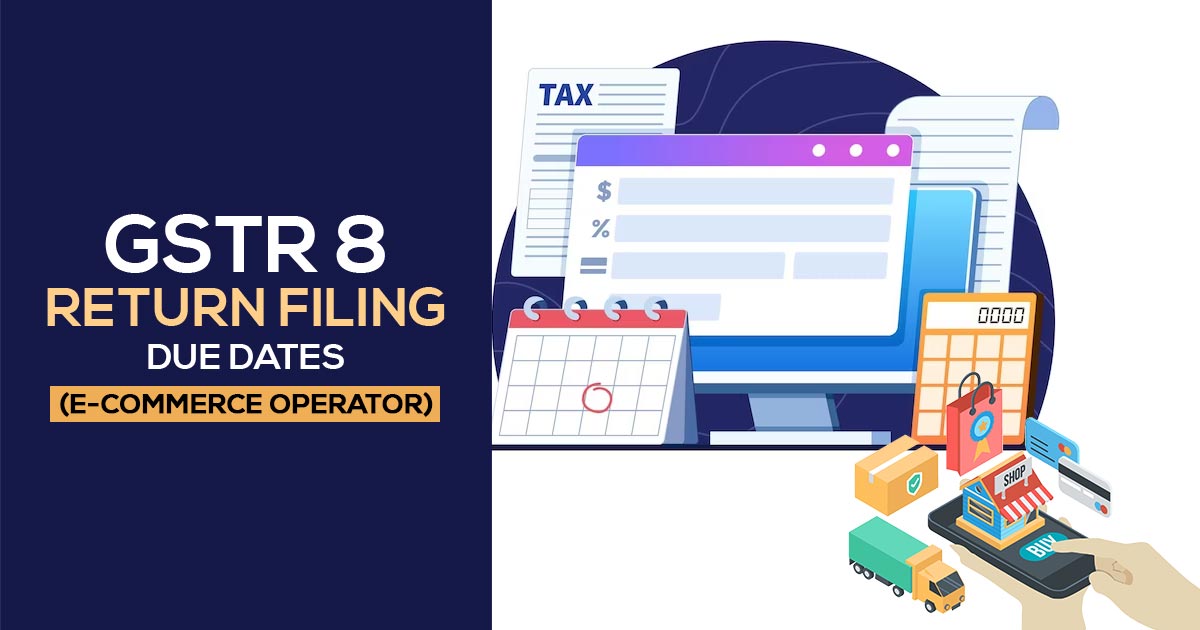
GSTR-8 is a return that e-commerce operators must file if they are obligated to deduct TCS (Tax collected at source) under GST. GSTR-8 comprises information on a supply made through an e-commerce platform and the amount of TCS collected on such goods. E-commerce businesses must file GSTR-8 forms on or before the 10th of each month. E-commerce firms are defined as anyone who owns, runs or manages a digital or electronic facility or platform for electronic commerce under GST. E-commerce businesses must get GST registration and be registered for tax collection at the source (TCS). In this blog post, we will discuss the complete retrun filing process for GSTR-8, including eligibility, due dates, and other related topics.
Who needs to file GSTR 8?
GSTR 8 must be filed by an e-commerce firm that is GST-registered. These companies must register for GST and get tax collection at the source registration. It includes supplies delivered by the e-commerce platform to both registered and unregistered clients, as well as taxes paid and owed. The paperwork detailing the amount of tax received from vendors at the point of sale is submitted by the e-commerce operator.
How Required To File Form GSTR-8?
It is not necessary to file Form GSTR-8 for each tax period. When goods are supplied through such operator and they have collected any TCS amount during the said tax period, or they have to amend any details declared in earlier returns on their own or on account of any details rejected by the supplier, which is auto-populated in Table 4 of the said return in that tax period, the e-commerce operator needs to file Form GSTR-8 for that tax period.
Why is GSTR-8 Essential?
GSTR-8 outlines the supply made through the e-commerce platform as well as the TCS collected on such deliveries. The Government has currently placed the TCS provisions on hold. It will take effect on October 1, 2018. If TCS is applicable, the supplier can claim the input credit for the TCS deducted by the e-commerce operator when the e-commerce operator files the GSTR-8. The amount of such TCS will be shown in Part C of the supplier’s Form GSTR-2A.
For example, assume that Shanta Enterprises supplies garments worth Rs 20,000 through Amazon. Now, Amazon, being the e-commerce operator, deduct the TCS @ 1% and deposits Rs 200 with the Government. The amount of Rs 200 will be shown in GSTR-2A of Shanta Enterprises after the filing of GSTR-8 by Amazon.
Under GST, when would TCS be Applicable?
For the e-commerce operators, the TCS provisions would be subjected to be applied. Hence, any individual who owns, functions, or handles the digital or electronic utility or platform towards electronic commerce would be required to enrol for the TCS and the monthly GSTR-8 filings. Towards e-commerce sellers, the GST TCS provisions would not be pertinent.
For instance, an Amazon seller (referred to as “seller” as of now) lists goods on Amazon.in (referred to as “E-commerce operator” as of now). The seller provides the goods and generates an invoice after receiving an order for the product. The E-commerce operator collects money from the customer, makes the deduction, and passes it on to the seller.
In these transactions, 1% of TCS will be deducted from the supplier by E-commerce operators. This deduction will be on the net value of goods/services sold by the E-commerce operator.
Important Features of the GSTR 8 Return Form
- Every registered E-commerce operator must file GSTR 8.
- Compulsorily, every E-commerce operator must file a GSTR-8 on or before the 10th of the coming month of a tax period.
- In part D of GSTR 2a, the details of the GSTR-8, which is filed by the E-commerce operator, are present.
- GSTR-8 contains 8 headings, and most of them are auto-filled.
- From the supplier of goods and services and returns to the government, E-commerce portals deduct the Tax Collection at Source (TCS).
- On all the goods and services that are sold out through the portals, 1% of TCS is paid by E-commerce operators.
Latest Update:
Advisory for the Changes in GSTR 8
Refer to the GST Council decision to the effect that the TCS rate has been lessened from the current 1% (0.5% CGST + 0.5% SGST/UTGST, or 1% IGST) to 0.5% (0.25% CGST + 0.25% SGST/UTGST, or 0.5% IGST) effective from 10/07/2024 vide Notification No. 15/2024 dated 10.07.2024.
Therefore, the following important aspects concerning the TCS rates effective from 10.07.2024 are to be noted:
1. Period from 1st July to 9th July 2024:
• In this period, the old TCS rate of 1% will continue to apply. The assessees are required to collect & report TCS at this rate for all transactions that happened between these dates.
2. With effect from 10th July 2024:
• An amended TCS rate of 0.5% will come into force from 10th July 2024. The assessee should ensure that their systems and processes are updated to show this new rate for all transactions that occurred from 10th July forward.
Some assesses have been notified about the validation error at the time of filing the GSTR-8 for July 2024, it is to be notified that the GSTN team is working on the revisions announced by the GST council for the GSTR 8, which is anticipated to be finished in the forthcoming couple of days and the users shall be enabled to file the returns from 06th August 2024 midnight onwards. Any inconvenience induced in this matter is regretted.

GSTR 8 Eligibility and Due Dates December 2025
An E-commerce operator can file GSTR-8 after the month ends, and the last date to file the details is the 10th of the next month of the tax period.
| Return Monthly | Due Date |
|---|---|
| December 2025 | 10th January 2026 |
| November 2025 | 10th December 2025 |
| October 2025 | 10th November 2024 |
| September 2025 | 10th October 2025 |
| August 2025 | 10th September 2025 |
| July 2025 | 10th August 2025 |
| June 2025 | 10th July 2025 |
| May 2025 | 10th June 2025 |
| April 2025 | 10th May 2025 |
| March 2025 | 10th April 2025 |
| February 2025 | 10th March 2025 |
| January 2025 | 10th February 2025 | December 2024 | 12th January 2025 | Extended |
| November 2024 | 10th December 2024 |
| October 2024 | 10th November 2024 |
| September 2024 | 10th October 2024 |
Latest Update :
- The GST Network (GSTN) has announced an Advisory to file pending returns before the expiry of three years. GST returns can only be filed within three years from their due dates.” Read the Official copy of the Advisory
- The Central Board of Indirect Taxes and Customs (CBIC), under the Ministry of Finance, has extended the due date for filing Form GSTR 7 to the 12th of January 2024. Read Notification
Important Terms Related to GSTR 8
- GSTIN: Goods and Services Taxpayer Identification Number
- UIN: Unique Identification Number
- UQC: Unit Quantity Code
- HSN: Harmonised System of Nomenclature
- SAC: Services Accounting Code
- POS: Place of Supply of Goods and Services
- B2B: Business to business
- B2C: Business to Customer
Interest & Penalty on Late Payment of GST
If you delay filing the GSTR-8 return, you are bound to pay Rs 200/day, where Rs. 100 is CGST, and Rs. 100 is SGST/UTGST per day. But the taxpayer is liable to pay a maximum penalty of Rs. 5,000.
Moreover, with the late fee, the taxpayer is also liable to pay an annual interest of 18% based on the amount of unpaid tax.







